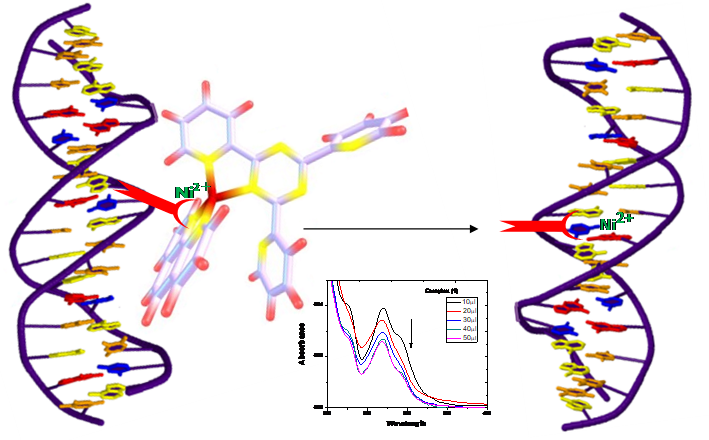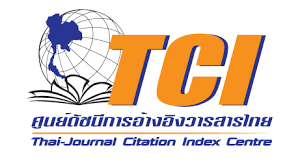Mechanochemical synthesis of Ni(II)-tptz complexes with co-ligands: Spectroscopy, DFT, and biological studies
DOI:
https://doi.org/10.55713/jmmm.v35i2.2324Keywords:
Vibrational spectra, Electronic spectra, Ni (II) mixed ligand complexes, DNA binding, Antimicrobacterial studyAbstract
New mixed-ligand Ni(II) complexes [Ni(tptz)(1,10-phen)] (1), [Ni(tptz)(2-Mimd)2] (2), and [Ni(tptz)Imd)2] (3) were synthesized via a green, solvent-free mechanochemical approach using ball milling. The primary ligand used was 2,4,6-tris(2-pyridyl)-1,3,5-triazine (tptz), with secondary ligands being 1,10-phenanthroline, 2-methyl imidazole, and imidazole, respectively. Structural characterization by IR, UV-Visible, photoluminescence spectroscopy, and powder X-ray diffraction, supported by DFT calculations, revealed a distorted square planar geometry for complex 1 and distorted tetrahedral geometries for complex-2 and complex-3. Notably, bathochromic shifts in the UV-Vis spectra confirm metal-ligand charge transfer transitions and extended π-delocalization. Powder XRD analysis determined average crystallite sizes of 17.86 nm (1), 25 nm (2), and 14.7 nm (3). DNA-binding studies against calf thymus DNA exhibited bathochromic and hypochromic shifts, indicating an intercalative binding mode. Antibacterial evaluation showed that complexe-2 and complex-3 exhibited enhanced activity against Bacillus subtilis and Escherichia coli, with inhibition zones up to 16 mm, compared to their uncoordinated ligands. These results highlight the potential of Ni(II) coordination complexes as bioactive agents.
Downloads
References
M. Ismael, A.-M. M. Abdel-Mawgoud, M. K. Rabia, and A. Abdou, “Synthesis, characterization, molecular modeling and preliminary biochemical evaluation of new copper (II) mixed-ligand complexes,” Journal of Molecular Structure, vol. 1227, p. 129695, 2021. DOI: https://doi.org/10.1016/j.molstruc.2020.129695
G. G. Mohamed, A. A. El-Sherif, M. A. S. S. E. A. El-Sawy, and Sh. M. Morgan, “Mixed-ligand complex formation of tenoxicam drug with some transition metal ions in presence of valine: Synthesis, characterization, molecular docking, potentiometric and evaluation of the humeral immune response of calves,” Journal of Molecular Liquids, vol. 223, pp. 1311-1332, 2016. DOI: https://doi.org/10.1016/j.molliq.2016.09.065
H. Xine, L. A. Rifai, M. Faize, F. Bentiss, S. Guesmi, A. Laachir, A. Smaili, K. Makroum, A. Sahibed-Dine, and T. Koussa, “Induced resistance in tomato plants against Verticillium wilt by the binuclear nickel coordination complex of the ligand 2,5-bis(pyridin-2-yl)-1,3,4-thiadiazole,” Journal of Agricultural and Food Chemistry, vol. 64, no. 13, pp. 2661-2667, 2016. DOI: https://doi.org/10.1021/acs.jafc.6b00151
S. Shobana, P. Subramaniam, L. Mitu, J. Dharmaraja, and S. A. Narayan, “Synthesis, structural elucidation, biological, anti-oxidant and nuclease activities of some 5-Fluorouracil–amino acid mixed ligand complexes,” Spectrochimica Acta Part A: Molecular and Biomolecular Spectroscopy, vol. 134, pp. 333-344, 2015. DOI: https://doi.org/10.1016/j.saa.2014.06.093
S. Shobana, P. Subramaniam, J. Dharmaraja, and S. A. Narayan, “Stability and structural studies on Ni(II)-5-fluorouracil mixed ligand complex systems,” Journal of Solution Chemistry, vol. 45, no. 3, pp. 334-358, 2016. DOI: https://doi.org/10.1007/s10953-016-0440-7
T. Begum, K. Crouse, M. I. M. Tahir, A. R. Cowley, and M. Ali, “Synthesis, characterization and bioactivity of mixed-ligand Cu(II) complexes containing Schiff bases derived from S-benzyl-dithiocarbazate and saccharinate ligand and the X-ray crystal structure of the copper-saccharinate complex containing S-benzyl- β-N-(acetylpyrid-2-yl)methylenedithiocarbazate,” Polyhedron, vol. 26, no. 6, pp. 1159-1165, 2007. DOI: https://doi.org/10.1016/j.poly.2006.03.007
B. Annaraj, C. Balakrishnan, and M. A. Neelakantan, “Synthesis, structure information, DNA/BSA binding affinity and in vitro cytotoxic studies of mixed ligand copper(II) complexes containing a phenylalanine derivative and diimine co-ligands,” Journal of Photochemistry and Photobiology B: Biology, vol. 160, pp. 278-291, 2016. DOI: https://doi.org/10.1016/j.jphotobiol.2016.04.021
Q.-X. Wang, K. Jiao, F.-Q. Liu, X.-L. Yuan, and W. Sun, “Spectroscopic, viscositic and electrochemical studies of DNA interaction with a novel mixed-ligand complex of nickel (II) that incorporates 1-methylimidazole and thiocyanate groups,” Journal of Biochemical and Biophysical Methods, vol. 70, no. 3, pp. 427-433, 2007. DOI: https://doi.org/10.1016/j.jbbm.2006.09.011
T. Yoshida, T. Suzuki, K. Kanamori, and S. Kaizaki, “Synthesis, magnetic properties, and electronic spectra of octahedral mixed- ligand (β-diketonato) nickel(II) complexes with a chelated nitronyl nitroxide radical,” Inorganic Chemistry, vol. 38, no. 6, pp. 1059-1068, 1999. DOI: https://doi.org/10.1021/ic981283n
J. Y. Lu, M. A. Lawandy, J. Li, T. Yuen, and C. L. Lin, “A new type of two-dimensional metal coordination systems: Hydro-thermal synthesis and properties of the first oxalate−bpy mixed-ligand framework [M(ox)(bpy)] (M = Fe(II), Co(II), Ni(II), Zn(II); ox = C2O42-; bpy = 4,4‘-bipyridine) ,” Inorganic Chemistry, vol. 38, no. 11, pp. 2695-2704, 1999. DOI: https://doi.org/10.1021/ic990243w
Y. Aydogdu, F. Yakuphanoglu, A. Aydogdu, E. Tas, and A. Cukurovali, “Solid state electrical conductivity properties of copper complexes of novel oxime compounds containing oxolane ring,” Materials Letters, vol. 57, no. 24-25, pp. 3755-3760, 2003. DOI: https://doi.org/10.1016/S0167-577X(03)00174-5
S. G. Thangavelu, S. J. A. Pope, C. L. Cahill, “Synthetic, structural, and luminescence study of uranyl coordination polymers containing chelating terpyridine and trispyridyltriazine ligands,” CrystEngComm, vol. 17, no. 31, pp. 6236-6247, 2015. DOI: https://doi.org/10.1039/C5CE00984G
Z. Li, F. Gao, Z. Xiao, G. Ao, X. Wu, Y. Fang, Z. Nie, T-H. Wei, J. Yang, Y. Wang, X. Zhang, J. Zuo, and Y. Song, “Synthesis and third-order nonlinear optical properties of a sandwich-type mixed (phthalocyaninato)(schiff-base) triple-decker complexes,” Dyes and Pigments, vol. 119, pp. 70-74, 2015. DOI: https://doi.org/10.1016/j.dyepig.2015.03.025
O. Tamer, D. Avci, and Y. Atalay, “Synthesis, X-ray structure, spectroscopic characterization and nonlinear optical properties of nickel (II) complex with picolinate: A combined experimental and theoretical study,” Journal of Molecular Structure, vol. 1098, pp. 12-20, 2015. DOI: https://doi.org/10.1016/j.molstruc.2015.05.035
M. Muthuppalani, A. Al Otaibi, S. Balasubramaniyan, S. Manikandan, P. Manimaran, G. Mathubala, A. Manikandan, T. Kamal, A. Khan, H. M. Marwani, K. A. Alamry, and A. M. Asiri, "An in-vitro anti-inflammatory and anti-microbial essential on Ni(II), Cd(II) mixed ligand complexes by using 2,4-dinitro-phenyl hydrazine and dimethylglyoxime." Journal of King Saud University-Science, vol 34, no. 5, p. 102114, 2022. DOI: https://doi.org/10.1016/j.jksus.2022.102114
F. Islam, Md. A. Hossain, N. M. Shah, H. T. Barua, Md. A. Kabir, M. J. Khan, and R. Mullick, “Synthesis, characterization, and antimicrobial activity studies of Ni(II) complex with pyridine as a ligand,” Journal of Chemistry, vol. 2015, no. 1, p. 525239, 2015. DOI: https://doi.org/10.1155/2015/525239
C. J. Dhanaraj, and J. Johnson, “Quinoxaline based bio-active mixed ligand transition metal complexes: Synthesis, characterization, electrochemical, antimicrobial, DNA binding, cleavage, antioxidant and molecular docking studies,” Journal of Photochemistry and Photobiology B: Biology, vol. 151, pp. 100-109, 2015. DOI: https://doi.org/10.1016/j.jphotobiol.2015.07.010
F. X. Campos, M. R. S. Soares, A. J. Terezo, and A. B. Siqueira, “Synthesis, characterization, and antioxidant evaluation of solid-state mefenamates of some bivalent metals,” Journal of Thermal Analysis and Calorimetry, vol. 115, no. 1, pp. 167-176, 2014. DOI: https://doi.org/10.1007/s10973-013-3275-0
T. M. Hunter, I. W. McNae, D. P. Simpson, A. M. Smith, S. Moggach, F. White, M. D. Walkinshaw, S. Parsons, and P. J. Sadler, “Configurations of nickel-cyclam antiviral complexes and protein recognition,” Chemistry - A European Journal, vol. 13, no. 1, pp. 40-50, 2007. DOI: https://doi.org/10.1002/chem.200601334
M. H. Soliman, G. G. Mohamed, and A. M. M. Hindy, “Biological activity, spectral and thermal characterization of mixed ligand complexes of enrofloxacin and glycine: in vitro antibacterial and antifungal activity studies,” Monatshefte für Chemie - Chemical Monthly, vol. 146, no. 2, pp. 259-273, 2015. DOI: https://doi.org/10.1007/s00706-014-1315-5
A. Kareem, Laxmi, M. Arshad, S. A. A. Nami, and N. Nishat, “Herbo-mineral based Schiff base ligand and its metal complexes: Synthesis, characterization, catalytic potential and biological applications,” Journal of Photochemistry and Photobiology B: Biology, vol. 160, pp. 163-171, 2016. DOI: https://doi.org/10.1016/j.jphotobiol.2016.03.030
G. Psomas and D. P. Kessissoglou, “Quinolones and non-steroidal anti-inflammatory drugs interacting with copper(II), nickel(II), cobalt(II) and zinc(II): Structural features, biological evaluation and perspectives,” Dalton Transactions, vol. 42, no. 18, pp. 6252-6276, 2013. DOI: https://doi.org/10.1039/c3dt50268f
M. Monti, V. Ciccone, A. Pacini, R. Roggeri, E. Monzani, L. Casella, and L. Morbidelli, “Anti-hypertensive property of a nickel-piperazine/NO donor in spontaneously hypertensive rats,” Pharmacological Research, vol. 107, pp. 352-359, 2016. DOI: https://doi.org/10.1016/j.phrs.2016.03.033
W. J. Hoekstra, T. Y. Hargrove, Z. Wawrzak, D. G. J. Batista, C. F. da Silva, A. S. G. Nefertiti, G. Rachakonda, R. J. Schotzinger, F. Villalta, M. de. Nazare C. Soeiro, and G. I. Lepesheva, “Clinical candidate VT-1161's antiparasitic effect In Vitro, activity in a murine model of chagas disease, and structural characterization in complex with the target enzyme CYP51 from Trypanosoma cruzi,” Antimicrobial Agents and Chemotherapy, vol. 60, no. 5, pp. AAC-02287, 2016. DOI: https://doi.org/10.1128/AAC.02287-15
M. M. Abd-Elzaher, A. A. Labib, H. A. Mousa, S. A. Moustafa, M. M. Ali, and A. A. El-Rashedy, “Synthesis, anticancer activity and molecular docking study of Schiff base complexes containing thiazole moiety,” Beni-Suef University Journal of Basic and Applied Sciences, vol. 5, no. 1, pp. 85-96, 2016. DOI: https://doi.org/10.1016/j.bjbas.2016.01.001
C. Zhao, X. Chen, D. Zang, X. Lan, S. Liao, C. Yang, P. Zhang, J. Wu, X. Li, N. Liu, Y. Liao, H. Huang, X. Shi, L. Jiang, X. Liu, Z. He, Q. P. Dou, X. Wang, and J. Liu, “A novel nickel complex works as a proteasomal deubiquitinase inhibitor for cancer therapy,” Oncogene, vol. 35, no. 45, pp. 5916-5927, 2016. DOI: https://doi.org/10.1038/onc.2016.114
U. M. Rafi, D. Mahendiran, A. K. Haleel, R. P. Nankar, M. Doble, and A. K. Rahiman, “New pyridazine-based binuclear nickel(II), copper(II) and zinc(II) complexes as prospective anticancer agents,” New Journal of Chemistry, vol. 40, no. 3, pp. 2451-2465, 2016. DOI: https://doi.org/10.1039/C5NJ02739J
P. Byers, G. Y. S. Chan, M. G. B. Drew, M. J. Hudson, and C. Madic, “Concomitant binding of a nickel(II) cation and a nitrate anion by the ligand 2,4,6-tri-2-pyridyl-1,3,5-triazine (TPTZ): The crystal structure of [Ni(HTPTZ)(H2O)3]3+∙3NO3−∙
H2O,” Polyhedron, vol. 15, no. 17, pp. 2845-2849, 1996.
A. Kamiyama, T. Noguchi, T. Kajiwara, and T. Ito, “A graphite-like complex with large cavities constructed with the complex ligand [NiII(bpca)2],” Angewandte Chemie International Edition, vol. 39, no. 17, pp. 3130-3132, 2000. DOI: https://doi.org/10.1002/1521-3773(20000901)39:17<3130::AID-ANIE3130>3.0.CO;2-I
A. Burkhardt, and W. Plass, “Modeling the coordination chemistry of chitosan: Synthesis and characterization of a nickel(II) complex with a 2-aminoglucose Schiff-base ligand,” Inorganic Chemistry Communications, vol. 11, no. 3, pp. 303-306, 2008. DOI: https://doi.org/10.1016/j.inoche.2007.12.006
C. R. De Silva, J. Wang, M. D. Carducci, S. A. Rajapakshe, and Z. Zheng, “Synthesis, structural characterization and luminescence studies of a novel europium(III) complex [Eu (DBM)3(TPTZ)] (DBM: dibenzoylmethanate; TPTZ: 2,4,6-tri(2-pyridyl)-1,3,5-triazine) ,” Inorganica Chimica Acta, vol. 357, no. 3, pp. 630-634, 2004. DOI: https://doi.org/10.1016/j.ica.2003.08.006
W. H. Al-Assy, A. M. H. El-Askalany, and M. M. Mostafa, “Structural comparative studies on new MnII, CrIII and RuIII complexes derived from 2,4,6-tri-(2-pyridyl)-1,3,5-triazine (TPTZ),” Spectrochimica Acta, Part A: Molecular and Biomolecular Spectroscopy, vol. 116, pp. 401-407, 2013. DOI: https://doi.org/10.1016/j.saa.2013.07.086
M. Maghami, F. Farzaneh, J. Simpson, and M. Azarkish, “Synthesis, crystal structure and characterization a new ionic complex MoO2Cl3(MeOH)∙H3tptz∙Cl2 (tptz = 2,4,6-tris(2-
pyridyl)-1,3,5-triazine) as epoxidation catalyst,” Inorganica Chimica Acta, vol. 445, pp. 28-36, 2016. DOI: https://doi.org/10.1016/j.ica.2016.02.015
M. M. Najafpour, M. Holynska, A. N. Shamkhali, M. Amini, S. H. Kazemi, S. Zaynalpoor, R. Mohamadi, M. Bagherzaden, and T. Lis, “New mononuclear manganese(II) complexes with 2,4,6-tris(2-pyridyl)-1,3,5-triazine (tptz) – selective catalyst in UHP oxidation of sulfides,” Polyhedron, vol. 34, no. 1, pp. 202-209, 2012. DOI: https://doi.org/10.1016/j.poly.2011.12.027
A. D. Becke, “Density-functional thermochemistry. III. The role of exact exchange,” Journal of Chemical Physics, vol. 98, no. 7, pp. 5648-5652, 1993. DOI: https://doi.org/10.1063/1.464913
C. Lee, W. Yang, and R. G. Parr, “Development of the Colle-Salvetti correlation-energy formula into a functional of the electron density,” Physical Review B, vol. 37, no. 2, pp. 785-789, 1988. DOI: https://doi.org/10.1103/PhysRevB.37.785
V. A. Rassolov, J. A. Pople, M. A. Ratner, and T. L. Windus, “6-31G* basis set for atoms K through Zn,” Journal of Chemical Physics, vol. 109, no. 4, pp. 1223-1229, 1998. DOI: https://doi.org/10.1063/1.476673
Gaussian 09, Revision A.02, M. J. Frisch, G. W. Trucks, H. B. Schlegel, G. E. Scuseria, M. A. Robb, J. R. Cheeseman, G. Scalmani, V. Barone, G. A. Petersson, H. Nakatsuji, X. Li, M. Caricato, A. Marenich, J. Bloino, B. G. Janesko, R. Gomperts, B. Mennucci, H. P. Hratchian, J. V. Ortiz, A. F. Izmaylov, J. L. Sonnenberg, D. Williams-Young, F. Ding, F. Lipparini, F. Egidi, J. Goings, B. Peng, A. Petrone, T. Henderson, D. Ranasinghe, V. G. Zakrzewski, J. Gao, N. Rega, G. Zheng, W. Liang, M. Hada, M. Ehara, K. Toyota, R. Fukuda, J. Hasegawa, M. Ishida, T. Nakajima, Y. Honda, O. Kitao, H. Nakai, T. Vreven, K. Throssell, J. A. Montgomery, Jr., J. E. Peralta, F. Ogliaro, M. Bearpark, J. J. Heyd, E. Brothers, K. N. Kudin, V. N. Staroverov, T. Keith, R. Kobayashi, J. Normand, K. Raghavachari, A. Rendell, J. C. Burant, S. S. Iyengar, J. Tomasi, M. Cossi, J. M. Millam, M. Klene, C. Adamo, R. Cammi, J. W. Ochterski, R. L. Martin, K. Morokuma, O. Farkas, J. B. Foresman, and D. J. Fox, Gaussian, Inc., Wallingford CT, 2016.
K. Abdi, H. Hadadzadeh, M. Salimi, J. Simpson, and A. D. Khalaji, “A mononuclear copper(II) complex based on the polypyridyl ligand 2,4,6-tris(2-pyridyl)-1,3,5-triazine (tptz), [Cu(tptz)2]2+: X-ray crystal structure, DNA binding and in vitro
cell cytotoxicity,” Polyhedron, vol. 44, no. 1, pp. 101-112, 2012. DOI: https://doi.org/10.1016/j.poly.2012.06.089
I. Ucar, O. Z. Yesilel, A. Bulut, H. Olmez, and O. Buyukgungor, “Tris(1,10-phenanthroline)nickel(II) squarate octa¬hydrate,” Acta Crystallographica Section C-crystal Structure Communications, vol. 61, no. 8, pp. m947-m949, 2005. DOI: https://doi.org/10.1107/S1600536805012055
R. Zibaseresht, and R. M. Hartshorn, “The nickel(II)/2,4,6-Tris (2-pyridyl)-1,3,5-triazine system: Synthesis and crystallographic characterization of a series of complexes,” Australian Journal of Chemistry, vol. 58, no. 5, pp. 345-353, 2005. DOI: https://doi.org/10.1071/CH04280
H. Hadadzadeh, M. Maghami, J. Simpson, K. Abdi, A. D. Khalaji, and K. Abdi, “Nickel(II) polypyridyl complexes of 2,4,6-Tris(2-pyridyl)-1,3,5-triazine,” Journal of Chemical Crystallography, vol. 42, no. 6, pp. 656-667, 2012. DOI: https://doi.org/10.1007/s10870-012-0296-7
M. S. S. Babu, B. U. Rao, V. Krishna, S. Mustafa, and G. N. Rao, “Synthesis, characterization and DNA cleavage studies of isomeric pyridyl-tetrazole ligands and their Ni(II) and Zn(II) complexes,” Journal of Saudi Chemical Society, vol. 21, no. 3, pp. 291-299, 2017. DOI: https://doi.org/10.1016/j.jscs.2015.07.003
M. M. Najafpour, M. Holynska, M. Amini, S. H. Kazemi, T. Lis, and M. Bagherzadeh, “Two new silver(I) complexes with 2,4,6- tris(2-pyridyl)-1,3,5-triazine (tptz): Preparation, characterization, crystal structure and alcohol oxidation activity in the presence of oxone,” Polyhedron, vol. 29, no. 14, pp. 2837-2843, 2010. DOI: https://doi.org/10.1016/j.poly.2010.07.005
L. Wang, L. Zhang, and J. Zhang, “Improved ORR activity of non-noble metal electrocatalysts by increasing ligand and metal ratio in synthetic complex precursors,” Electrochimica Acta, vol. 56, no. 16, pp. 5488-5492, 2011. DOI: https://doi.org/10.1016/j.electacta.2011.03.049
P. Kavitha, and K. L. Reddy, “Pd(II) complexes bearing chromone based Schiff bases: Synthesis, characterisation and biological activity studies,” Arabian Journal of Chemistry, vol. 9, no. 5, pp. 640-648, 2016. DOI: https://doi.org/10.1016/j.arabjc.2013.06.018
A. Panda, K. K. Das, K. R. Kaja, M. Belal, and B. K. Panigrahi, “Single electrode mode triboelectric nanogenerator for recognition of animal sounds,” Journal of Metals, Materials and Minerals, vol. 34, no. 4, p. e2170, 2024. DOI: https://doi.org/10.55713/jmmm.v34i4.2170
S. J. Azahari, M. H. Abdel Rhman, and M. M. Mostafa, “Spectroscopic, analytical and DFT calculation studies of two novel Al3+ complexes derived from 2,4,6-tri-(2-pyridyl)-1,3,5-triazine (TPTZ),” Spectrochimica Acta, Part A: Molecular and Biomolecular Spectroscopy, vol. 132, pp. 165-173, 2014. DOI: https://doi.org/10.1016/j.saa.2014.03.073
Z. Onal, H. Zengin, and M. Sonmez, “Synthesis, characterization, and photoluminescence properties of Cu(II), Co(II), Ni(II), and Zn(II) complexes of N-aminopyrimidine-2-thione,” Turkish Journal of Chemistry, vol. 35, no. 6, pp. 905-914, 2011. DOI: https://doi.org/10.3906/kim-1103-55
A-L. Wang, D. Zhou, Y-N. Chen, J-J. Li, H-X. Zhang, Y-L. Zhao, and H-B. Chu, “Crystal structure and photo-luminescence of europium, terbium and samarium compounds with halogen-benzoate and 2,4,6-tri(2-pyridyl)-s-triazine,” Journal of Luminescence, vol. 177, pp. 22-30, 2016. DOI: https://doi.org/10.1016/j.jlumin.2016.04.024
S. P. Parua, P. Mondal, P. Pattanayak, and S. Chattopadhyay, “Synthesis, structure and photoluminescence properties of functionalized azoimine ligands and their nickel complexes,” Polyhedron, vol. 89, pp. 142-148, 2015. DOI: https://doi.org/10.1016/j.poly.2015.01.004
H. A. Shahid, S. Jahangir, S. Yousuf, M. Hanif, and S. K. Sherwani, Synthesis, crystal structure, structural characterization and in vitro antimicrobial activities of 1-methyl-4-nitro-1H-imidazole,” Arabian Journal of Chemistry, vol. 9, no. 5, pp. S668-S675, 2016. DOI: https://doi.org/10.1016/j.arabjc.2014.11.001
P. Subbaraj, A. Ramu, N. Raman, and J. Dharmaraja, “Synthesis, characterization, DNA interaction and pharmacological studies of substituted benzophenone derived Schiff base metal(II) complexes,” Journal of Saudi Chemical Society,vol. 19, no. 2, pp. 207-216, 2015. DOI: https://doi.org/10.1016/j.jscs.2014.05.002

Downloads
Published
How to Cite
License
Copyright (c) 2025 Journal of Metals, Materials and Minerals

This work is licensed under a Creative Commons Attribution-NonCommercial-NoDerivatives 4.0 International License.
Authors who publish in this journal agree to the following terms:
- Authors retain copyright and grant the journal right of first publication with the work simultaneously licensed under a Creative Commons Attribution License that allows others to share the work with an acknowledgment of the work's authorship and initial publication in this journal.
- Authors are able to enter into separate, additional contractual arrangements for the non-exclusive distribution of the journal's published version of the work (e.g., post it to an institutional repository or publish it in a book), with an acknowledgment of its initial publication in this journal.












